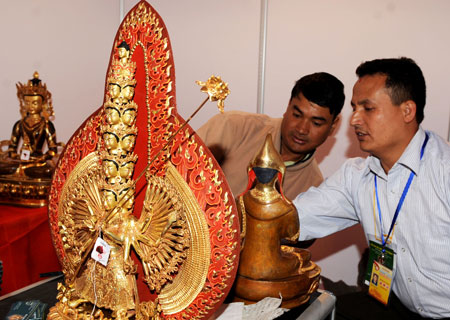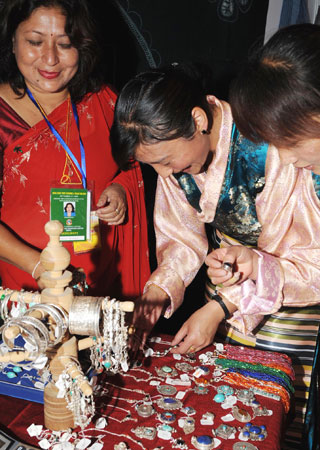
Picture shows two Nepalese businessmen shows Buddha statues during a trade fair between China's Tibet Autonomous Region and Nepal at the Mt. Qomolangma Exhibition Center in Xigaze, southwest China's Tibet Autonomous Region, Sep. 3, 2009. Chinese and Nepalese businesses gathered in Xigaze City Thursday for a five-day trade fair that highlights Buddha statues, Tibetan medicine and other commodities from the Himalayan region, photo from Xinhua.
Chinese and Nepalese businesses gathered in Xigaze City in southwest China's Tibet Autonomous Region Thursday for a five-day trade fair that highlights Buddha statues, Tibetan medicine and other commodities from the Himalayan region.
A total of 171 businesses from the two countries have set up booths at the fair, which opened Thursday morning at the Mt. Qomolangma Exhibition Center in Xigaze, at the foot of the world's tallest peak.
Most Nepalese businesses have brought traditional artwork, textile products and food, while Chinese companies are displaying herbs, art-ware and electrical appliances.
Nepalese businesswoman Meera Shakya posed for a photo at her booth, where a wide variety of handmade shawls, scarves, purses and ornaments were on display. "I'm confident these products will sell well in China," she said.
The trade fair is expected to further boost Nepal's trade relations and cultural exchanges with China, said Purushottam Ojha, secretary of the Nepalese Ministry of Commerce and Supplies, at the event's opening ceremony.
Picutre shows Tibetan girls choose Nepalese accessories during a trade fair between China's Tibet Autonomous Region and Nepal at the Mt. Qomolangma Exhibition Center in Xigaze, in southwest China's Tibet Autonomous Region, Sep. 3, 2009, photo from Xinhua.
"It will enhance the two countries' traditional friendship, expand trade and promote economic and technical exchanges," said Deng Xiaogang, vice chairman of Tibet's regional government.
The Nepalese ministry signed a memorandum of understanding with Tibet's regional government Wednesday, which said the two sides would establish a trade coordination committee to promote trade and investment by simplifying procedures in customs clearance, transportation and other aspects.
The committee will meet annually in Lhasa and Kathmandu by turns and the first meeting will be held in six months, according to the MOU.
Last year, Tibet's Zham Port on the China-Nepal border handled 243 million U.S. dollars worth of two-way trade.

Picutre shows Tibetan girls choose Nepalese accessories during a trade fair between China's Tibet Autonomous Region and Nepal at the Mt. Qomolangma Exhibition Center in Xigaze, in southwest China's Tibet Autonomous Region, Sep. 3, 2009, photo from Xinhua.
